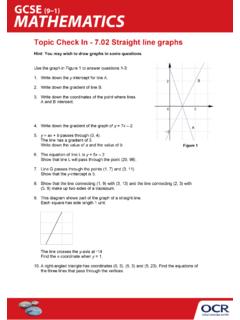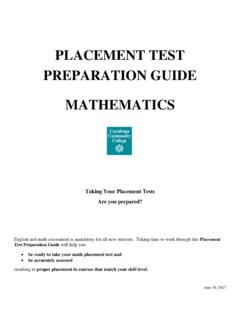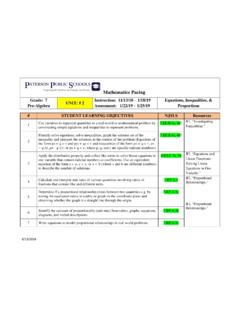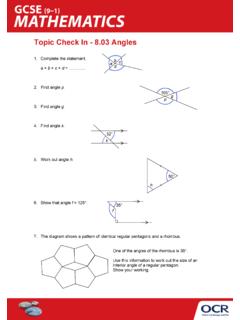Transcription of Georgia Standards of Excellence Curriculum …
1 These materials are for nonprofit educational purposes only. Any other use may constitute copyright infringement. Georgia Standards of Excellence Curriculum Frameworks GSE Grade 8 Unit 6: Linear Models and Tables mathematics Georgia Department of Education Georgia Standards of Excellence Framework GSE Grade 8 mathematics Unit 6 mathematics GSE Grade 8 Unit 6: Linear Models and Tables July 2018 Page 2 of 201 Unit 6 Linear Models and Tables Table of Contents OVERVIEW .. 3 Standards ADDRESSED IN THIS UNIT .. 4 Standards FOR MATHEMATICAL PRACTICE .. 4 Standards FOR MATHEMATICAL CONTENT .. 5 BIG IDEAS .. 5 ESSENTIAL QUESTIONS .. 6 CONCEPTS/SKILLS TO MAINTAIN .. 6 FLUENCY .. 6 SELECTED TERMS AND SYMBOLS .. 7 FALS .. 8 SPOTLIGHT TASKS .. 9 3-ACT TASKS .. 9 TASKS .. 10 Sugar Prices (Short Cycle Task) .. 12 Winter Is .. 15 Heartbeats .. 36 Styrofoam Cups (Spotlight Task).
2 46 Walk the Graph .. 49 Interpreting Distance-Time (FAL) .. 64 Forget the Formula .. 66 Heartbeats, Too .. 79 Mineral Samples .. 90 Walking Race and Making Money .. 96 Mini-Problems .. 121 My Cotton Boll Data .. 134 Outdoor Theater .. 157 How Long Should Shoe Laces Really Be? .. 165 25 Billion Apps .. 171 Sports and Musical Instruments .. 177 Two Way Tables .. 181 Culminating Task: Is the Data Linear? .. 192 TECHNOLOGY RESOURCES .. 200 Georgia Department of Education Georgia Standards of Excellence Framework GSE Grade 8 mathematics Unit 6 mathematics GSE Grade 8 Unit 6: Linear Models and Tables July 2018 Page 3 of 201 OVERVIEW In this unit students will: identify the rate of change and the initial value from tables, graphs, equations, or verbal descriptions; write a model for a linear function; sketch a graph when given a verbal description of a situation; analyze scatter plots; informally develop a line of best fit; use bivariate data to create graphs and linear models; and recognize patterns and interpret bivariate data.
3 Students are given opportunities and examples to figure out the meaning of y = mx + b. They will be able to see m and b in graphs, tables, and formulas or equations, and they need to be able to interpret those values in contexts. Using graphing calculators and web resources, students explore linear functions within context to build understanding of slope and y-intercept in a graph, especially for those patterns that do not start with an initial value of 0. Students gather their own data or graphs in contexts they understand. Students measure, collect data, graph data, and look for patterns, then generalize and symbolically represent the patterns. They draw graphs (qualitatively, based upon experience) representing real-life situations with which they are familiar. Students take a function in symbolic form and create a problem situation in words to match the function. Given a graph, students create a scenario that would fit the graph.
4 Students sort a set of cards to match graphs, tables, equations, and problem situations and explain their reasoning to each other. Building on the study of statistics using univariate data in Grades 6 and 7, students are now ready to study bivariate data. Students will extend their descriptions and understanding of variation to the graphical displays of bivariate data. Scatter plots are the most common form of displaying bivariate data in Grade 8. Students practice informally finding the line of best fit using a scatter plot. Students create and interpret scatter plots, focusing on outliers, positive or negative association, linearity or curvature. By changing the data slightly, students have a rich discussion about the effects of the change on the graph. Students use a graphing calculator to determine a linear regression and discuss how this relates to the graph. Students informally draw a line of best fit for a scatter plot and informally assess the fit of a function to their data.
5 The study of the line of best fit ties directly to the algebraic study of slope and intercept. Students interpret the slope and intercept of the line of best fit in the context of the data. Then Georgia Department of Education Georgia Standards of Excellence Framework GSE Grade 8 mathematics Unit 6 mathematics GSE Grade 8 Unit 6: Linear Models and Tables July 2018 Page 4 of 201 students make predictions based on the line of best fit. Student will construct and interpret two-way tables in order to summarize two categorical variables. Although the units in this instructional framework emphasize key Standards and big ideas at specific times of the year, routine topics such as estimation, mental computation, and basic computation facts should be addressed on an ongoing basis. Ideas related to the eight practice Standards should be addressed constantly as well.
6 To assure that this unit is taught with the appropriate emphasis, depth, and rigor, it is important that the tasks listed under Evidence of Learning be reviewed early in the planning process. A variety of resources should be utilized to supplement this unit. This unit provides much needed content information, but excellent learning activities as well. The tasks in this unit illustrate the types of learning activities that should be utilized from a variety of sources. Standards ADDRESSED IN THIS UNIT Standards FOR MATHEMATICAL PRACTICE Refer to the Comprehensive Course Overview for more detailed information about the Standards for Mathematical Practice. 1. Make sense of problems and persevere in solving them. 2. Reason abstractly and quantitatively. 3. Construct viable arguments and critique the reasoning of others. 4. Model with mathematics . 5.
7 Use appropriate tools strategically. 6. Attend to precision. 7. Look for and make use of structure. 8. Look for and express regularity in repeated reasoning. Mathematical Standards are interwoven and should be addressed throughout the year in as many different units and activities as possible in order to emphasize the natural connections that exist among mathematical topics. Georgia Department of Education Georgia Standards of Excellence Framework GSE Grade 8 mathematics Unit 6 mathematics GSE Grade 8 Unit 6: Linear Models and Tables July 2018 Page 5 of 201 Standards FOR MATHEMATICAL CONTENT Use functions to model relationships between quantities. Construct a function to model a linear relationship between two quantities. Determine the rate of change and initial value of the function from a description of a relationship or from two (x, y) values, including reading these from a table or from a value of a linear function in terms of the situation it models, and in terms of its graph or a table of values.
8 Describe qualitatively the functional relationship between two quantities by analyzing a graph ( , where the function is increasing or decreasing, linear or nonlinear). Sketch a graph that exhibits the qualitative features of a function that has been described verbally. Investigate patterns of association in bivariate data. Construct and interpret scatter plots for bivariate measurement data to investigate patterns of association between two quantities. Describe patterns such as clustering, outliers, positive or negative association, linear association, and nonlinear association. Know that straight lines are widely used to model relationships between two quantitative variables. For scatter plots that suggest a linear association, informally fit a straight line, and informally assess the model fit by judging the closeness of the data points to the line. Use the equation of a linear model to solve problems in the context of bivariate measurement data, interpreting the slope and intercept.
9 For example, in a linear model for a biology experiment, interpret a slope of cm/hr as meaning that an additional hour of sunlight each day is associated with an additional cm in mature plant height. Understand that patterns of association can also be seen in bivariate categorical data by displaying frequencies and relative frequencies in a two-way table. a. Construct and interpret a two-way table summarizing data on two categorical variables collected from the same subjects. b. Use relative frequencies calculated for rows or columns to describe possible association between the two variables. For example, collect data from students in your class on whether or not they have a curfew on school nights and whether or not they have assigned chores at home. Is there evidence that those who have a curfew also tend to have chores? BIG IDEAS Collecting and examining data can sometimes help one discover patterns in the way in which two quantities vary.
10 Changes in varying quantities are often related by patterns which, once discovered, can be used to predict outcomes and solve problems. Georgia Department of Education Georgia Standards of Excellence Framework GSE Grade 8 mathematics Unit 6 mathematics GSE Grade 8 Unit 6: Linear Models and Tables July 2018 Page 6 of 201 Written descriptions, tables, graphs, and equations are useful in representing and investigating relationships between varying quantities. Different representations (written descriptions, tables, graphs, and equations) of the relationships between varying quantities may have different strengths and weaknesses. Linear functions may be used to represent and generalize real situations. Slope and y-intercept are keys to solving real problems involving linear relationships. ESSENTIAL QUESTIONS What strategies can I use to help me understand and represent real situations involving linear relationships?

















